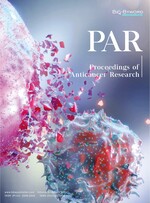The Level of Circulating Tumor Cells in Patients with Non-Small Cell Lung Cancer and Its Relationship with Tumor Markers
Abstract
Objective: To explore the level of circulating tumor cells in patients with non-small cell lung cancer and its relationship with tumor markers. Methods: Fifty patients with NSCLC admitted to a hospital from March 2019 to February 2022 were retrospectively selected as the research subjects; their clinical data were sorted out and analyzed. All patients were examined for CTCs. According to their levels, the patients were divided into a positive group (30 cases, ? 4%) and a negative group (20 cases, < 4%). The positive rate of peripheral CTCs in patients with different gender, age, and pathological types of NSCLC, the positive rate of peripheral CTCs in patients with different staging of NSCLC, and the relationship between serum CEA, CA125, CYFRA21-1, and peripheral CTCs were analyzed and observed. Results: There was no significant difference in gender, age, and pathological type between the positive group and the negative group. There was also no significant difference in the T staging, N staging, and M staging between the positive group and the negative group. However, there was significant difference in the clinical staging of the positive group and the negative group. The CEA, CA125, and CYFRA21-1 of the positive group were 7.45 ± 1.26, 38.56 ± 4.12, and 5.01 ± 1.36, respectively, whereas those of the negative group were 5.12 ± 1.22, 32.69 ± 4.01, and 3.87 ± 1.25, respectively. The comparison between the two groups was statistically significant. Conclusion: CTCs provide the possibility of detecting cancer before the use of imaging methods, guide treatment in combination with other tumor markers, monitor postoperative treatment, and predict patients’ outcome.
References
Zhang Y, Zhang Z, Yin X, et al., 2022, The Role and Research Progress of Self Implantation of Circulating Tumor Cells in the Progression of Malignant Tumors. Modern Oncology, 30(06): 1113–1117.
Qin Y, 2022, Research Progress of Circulating Tumor Cells in Early Screening of Hepatocellular Carcinoma. Modern Oncology Medicine, 30(06): 1133–1137.
Shen S, Huang J, Li X, 2022, Research Progress of Circulating Tumor Cell Enrichment Technology. Laboratory Medicine, 37(01): 91–96.
Luo N, Zhong P, Zhang J, et al., 2022, Efficacy of Endu Combined with Concurrent Radiotherapy and Chemotherapy in the Treatment of Non-Small Cell Lung Cancer and Its Effect on Peripheral Blood CTC, VEGF and 3-Year Survival. Western Medicine, 34(01): 84–87 + 93.
Chen P, Jiang P, Yang M, 2022, Research Progress on Invasion and Metastasis of Circulating Tumor Cells in Lung Cancer. Cancer Progression, 20(01): 5–7.
Che K, Cha G, 2021, Clinical Application of Circulating Tumor Cells in the Evaluation of Chemotherapy Efficacy of Advanced Non-Small Cell Lung Cancer. Jiangxi Medicine, 56(12): 2351–2353 + 2369.
Wen S, Zhou D, Xu Y, et al., 2021, The Value of Folic Acid Receptor Positive Circulating Tumor Cell Detection in Early Diagnosis of Lung Adenocarcinoma and Evaluation of Surgical Efficacy. Chinese Journal of Clinical Laboratory Management, 9(04): 193–199.
Wu H, Shen M, Sun Y, et al., 2021, Differential Expression of Four Tumor Stem Cell Markers in Hepatocellular Carcinoma and Peripheral Blood Circulating Tumor Cells and Their Prognostic Value. Chinese Journal of Laboratory Medicine, 44(11): 1043–1050.
Luo Y, Cheng S, Chen W, 2021, Expression of High Mobility Group Protein A2 Glycochain Protein 125 in Circulating Tumor Cells and Its Relationship with Cellular Immune Function in Patients with Non-Small Cell Lung Cancer. Journal of Practical Medical Technology, 28(08): 1001–1004.
Zhou Z, Meng F, Zhao D, et al., 2021, Circulating Tumor Cell Typing and Its Clinical Application in Advanced Lung Cancer. International Journal of Laboratory Medicine, 42(15): 1874–1879.
Cai R, A X, Qi H, et al., 2021, Study on the Relationship Between Circulating Tumor Cells and Serum SCC Ag and Cy-Fra21-1 Levels in Patients with Non-Small Cell Lung Cancer. Progress in Modern Biomedicine, 21(14): 2778–2781.
Zhao Y, Li Y, Ding H, et al., 2021, Value Analysis of Circulating Tumor Cell Count in Evaluating Prognosis of Elderly Patients with Advanced Non-Small Cell Lung Cancer. Chinese Journal of Modern Medicine, 23(07): 6–10.
Deng K, Li Y, Liu G, et al., 2021, Clinical Study on the Use of Circulating Tumor Cells to Distinguish Benign and Malignant Lesions of Pulmonary Nodules. Journal of Wuhan University (Medical Edition), 42(06): 966–970.
Yu P, Zhu L, Que Z, et al., 2021, Research Progress in Circulating Tumor Cells of Lung Cancer. Cancer Prevention and Treatment Research, 48(05): 519–523.
Lu X, 2021, Application of Circulating Tumor Cells in Diagnosis and Treatment of Small Cell Lung Cancer. Beijing University of Traditional Chinese Medicine.
Wang Y, Guo S, Wang X, et al., 2021, Effect of Kangai Injection Combined with Bevacizumab on Circulating Tumor Cells and CA21-1 Level in Patients with Advanced Non-Small Cell Lung Cancer. Journal of Difficult Diseases, 20(09): 914–917 + 923.
Bo L, Wang X, Yu Z, et al., 2021, Research Progress of CPS1 Regulating the Occurrence and Development of Malignant Tumors. Modern Oncology, 29(20): 3654–3657.
Li H, Wang H, Sun Z, et al., 2021, Consistency of ctDNA Mutation Spectrum Between Tissues and Serum of Patients with Non-Small Cell Lung Cancer and Analysis of Related Factors. Modern Oncology, 29(17): 3023–3026.
Liu W, 2021, Analysis of the Consistency Between the Results of Preoperative Circulating Tumor DNA and Tumor Tissue DNA Detection in Non-Small Cell Lung Cancer. Zunyi Medical University.
Yan F, Ma Y, Song Y, et al., 2021, Value of Combined Detection of Multiple Tumor Markers in the Diagnosis of Non-Small Cell Lung Cancer. Journal of Practical Clinical Medicine, 25(09): 14–17.

